Red Hat Training
A Red Hat training course is available for Red Hat Enterprise Linux
群集套件概述
红帽企业版 Linux 5 的红帽群集套件
版 3
摘要
简介
- 《Red Hat Enterprise Linux 安装指南》 — 提供安装 Red Hat Enterprise Linux 5 的信息。
- 《Red Hat Enterprise Linux 部署指南》 — 提供关于 Red Hat Enterprise Linux 5 的部署、配置和管理的信息。
- 《配置和管理红帽群集系统》 — 提供安装、配置和管理红帽群集组件的信息。
- Logical Volume Manager Administration — Provides a description of the Logical Volume Manager (LVM), including information on running LVM in a clustered environment.
- 《全球文件系统:配置和管理》 — 提供安装、配置和维护红帽 GFS(红帽全球文件系统)的信息。
- 《全球文件系统 2:配置和管理》 — 提供安装、配置和维护红帽 GFS2(红帽全球文件系统 2)的信息。
- 《使用设备映射器多路径》 — 提供关于使用Red Hat Enterprise Linux 5 设备映射器多路径信息。
- 《在全球文件系统里使用 GNBD》 — 个关于在红帽全球文件系统(GFS)里使用全球网路块设备(Global Network Block Device,GNBD)的概述。
- 《Linux 虚拟服务器管理》 — 提供用 Linux 虚拟服务器(Linux Virtual Server,LVS)配置高性能的系统和服务的信息。
- 《红帽群集套件发行注记》 — 关于当前的红帽群集套件(Red Hat Cluster Suite)的发行注记。
1. 反馈
Cluster_Suite_Overview(EN)-5 (2009-08-18T15:49)
第 1 章 Red Hat Cluster Suite概述
1.1. 群集基础
- 存储型(Storage)
- 高可用性型(High availability)
- 负载平衡型(Load balancing)
- 高性能型(High performance)
注意
1.2. Red Hat Cluster Suite Introduction
- 群集基础结构 — 提供节点以群集方式一起工作所需的基本功能、配置文件管理、成员资格管理 、锁管理和安全管理。
- 高可用性服务管理 — 提供在某个节点不可操作时,服务从一个群集节点到另外一个节点的故障切换。
- 群集管理工具 — 用于设置、配置和管理Red Hat群集的配置和管理工具。这些工具和群集基础结构组件、高可用性和服务管理组件、存储组件一起使用。
- Linux 虚拟服务器(Linux Virtual Server,LVS)— 提供 IP 负载平衡的路由软件。LVS 在一对冗余的服务器中运行,它将客户请求均匀地分发到它后面的真实服务器。
- Red Hat GFS(全球文件系统,Global File System)— 提供和 Red Hat Cluster Suite 一起使用的群集文件系统。GFS 允许多个节点进行块级别的存储共享,就好像每个群集节点都连接至本地存储空间一样。
- 群集逻辑卷管理器(Cluster Logical Volume Manager,CLVM)— 提供群集存储的卷管理。
注意
When you create or modify a CLVM volume for a clustered environment, you must ensure that you are running theclvmddaemon. For further information, refer to 第 1.6 节 “群集逻辑卷管理器”. - 全球网络块设备(Global Network Block Device,GNBD)— GFS 的辅助组件,它将块级别的存储设备导出至以太网络。这是在 Red Hat GFS 中使用块级别存储的一个经济的方法。

图 1.1. Red Hat Cluster Suite Introduction
注意
1.3. Cluster Infrastructure
- 群集管理
- 锁管理
- Fencing
- 群集配置管理
1.3.1. 群集管理
注意

图 1.2. CMAN/DLM Overview
1.3.2. 锁管理
1.3.3. Fencing
fenced.
fenced 将保护(fence)故障节点。其他群集基础结构组件将决定采取什么行动 — 也就是说,它们执行任何必需的恢复。例如,当 DLM 和 GFS 被告知节点故障时,将暂停活动,直到它们检测到 fenced 已经完成对故障节点的保护。当确认故障节点已经被保护时,DLM 和 GFS 会执行恢复。DLM 释放对失败节点的锁定;GFS 恢复故障节点的日志。
- 电源保护(Power fencing)— 该方法使用电源控制器来关闭不可操作的节点。
- 光线通道开关保护(Fibre Channel switch fencing)— 该方法禁用连接至不可操作节点的光线通道端口。
- GNBD fencing — A fencing method that disables an inoperable node's access to a GNBD server.
- 其他保护方法 — 如禁用 I/O 或不可操作节点的电源,包括 IBM Bladecenters, PAP, DRAC/MC, HP ILO, IPMI, IBM RSA II 等。

图 1.3. Power Fencing Example

图 1.4. Fibre Channel Switch Fencing Example

图 1.5. Fencing a Node with Dual Power Supplies

图 1.6. Fencing a Node with Dual Fibre Channel Connections
1.3.4. 群集配置系统

图 1.7. CCS Overview

图 1.8. Accessing Configuration Information
/etc/cluster/cluster.conf)是一个 XML 文件,它描述了下列群集属性:
- 群集名 — 显示群集的名字、群集配置文件版本、当节点加入群集或被保护所使用的基本保护时间属性。
- 群集 — 显示群集的每个节点,指定节点名、节点 ID、quorum vote 的数量和其保护方法。
- 保护设备 — 显示群集里的保护设备。其参数根据保护设备的类型而有所不同。例如,对于用作保护设备的电源控制器,群集配置定义了电源控制器的名字、IP 地址、登录帐号和密码。
- 被管理的资源 — 显示创建群集服务所必需的资源。被管理的资源包括故障切换域的定义、资源(如 IP 地址)和服务。它也定义了群集服务和群集服务的故障切换行为。
1.4. 高可用性服务管理
rgmanager,它实现了 off-the-shelf 应用程序的冷失效切换(cold failover)。在 Red Hat 群集里,应用程序和其他群集资源进行配置来组成高可用性的群集服务。高可用性群集服务可以从一个节点故障切换到另外一个节点,而不会对群集客户有明显的影响。当某个群集节点发生故障或群集系统管理员将服务迁移(例如,需要对这个节点进行预定的维护时)到另外一个节点时,群集服务的故障切换都可以发生。
注意

图 1.9. 故障切换域
- IP 地址资源 — 10.10.10.201。
- An application resource named "httpd-content" — a web server application init script
/etc/init.d/httpd(specifyinghttpd). - A file system resource — Red Hat GFS named "gfs-content-webserver".

图 1.10. Web Server Cluster Service Example
1.5. Red Hat GFS
- 简化数据基础结构
- 整个群集只需安装一次应用程序或补丁
- 消除对应用程序数据的冗余拷贝(复制)的需要。
- 启用多个客户对数据的并行读/写操作。
- 简化备份和恢复(只需要备份或恢复一个文件系统)。
- 最大化对存储资源的使用;最小化存储的管理开销。
- 将存储作为一个整体而不是根据分区管理。
- 通过消除数据复制的需要从而减少总体的存储需求。
- 通过即时添加服务器或存储空间来无缝地扩展群集。
- 不需要复杂的技术来对存储空间分区。
- 通过挂载至普通文件系统来实时在群集里添加服务器。
注意
1.5.1. 出众的性能和灵活性

图 1.11. GFS with a SAN
1.5.2. 性能、灵活性、合适的价格

图 1.12. GFS and GNBD with a SAN
1.5.3. 经济性和性能

图 1.13. 使用直连存储设备的 GFS 和 GNBD
1.6. 群集逻辑卷管理器
clvmd. clvmd is a daemon that provides clustering extensions to the standard LVM2 tool set and allows LVM2 commands to manage shared storage. clvmd runs in each cluster node and distributes LVM metadata updates in a cluster, thereby presenting each cluster node with the same view of the logical volumes (refer to 图 1.14 “CLVM Overview”). Logical volumes created with CLVM on shared storage are visible to all nodes that have access to the shared storage. CLVM allows a user to configure logical volumes on shared storage by locking access to physical storage while a logical volume is being configured. CLVM uses the lock-management service provided by the cluster infrastructure (refer to 第 1.3 节 “Cluster Infrastructure”).
注意
clvmd)或者高可用性逻辑卷管理代理(HA-LVM)。如果您无法使用 clvmd 守护进程或者 HA-LVM,无论是因为操作原因还是您没有正确的权利,您就一定不能在共享磁盘中使用单一事件 LVM,因为这将导致数据崩溃。如果您有任何疑问,请联络您的红帽服务代表。
注意
/etc/lvm/lvm.conf 进行群集范围的锁定方面的少许修改。

图 1.14. CLVM Overview

图 1.15. LVM Graphical User Interface

图 1.16. Conga LVM Graphical User Interface

图 1.17. Creating Logical Volumes
1.7. 全球网络块设备

图 1.18. GNBD 概述
1.8. Linux 虚拟服务器
- 在真实服务器之间平衡负载。
- 检查每个真实服务器上的服务的完整性。
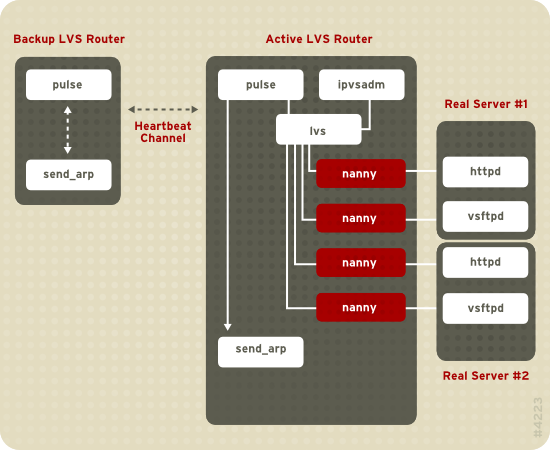
图 1.19. Components of a Running LVS Cluster
pulse 守护进程运行在活动的以及备份 LVS 路由器上。在备份 LVS 路由器上,pulse 发送 heartbeat 到活动路由器的公用接口,确保活动路由器正常工作。在活动的 LVS 路由器上,pulse 启动 lvs 守护进程并响应备份 LVS 路由器的 heartbeat 查询。
lvs 守护进程将调用 ipvsadm 工具来配置和维护内核里的 IPVS(IP 虚拟服务器)路由表,并为每台真实服务器上配置的的每个虚拟服务器启动一个 nanny 进程。每个 nanny 进程检查一台真实服务器上的一个配置好的服务的状态,并告诉 lvs 守护进程这个服务是否发生了故障。如果检测到了故障,lvs 守护进程将指引 ipvsadm 从 IPVS 路由表中删除那台真实服务器的条目。
send_arp 将所有虚拟 IP 地址重新分配给备份 LVS 路由器的 NIC 硬件地址(MAC 地址),并通过公用以及专用网络接口向活动的 LVS 路由器发送命令来关闭其 lvs 守护进程,然后在备份 LVS 路由器上启动 lvs 守护进程来接受虚拟服务器的请求。
- 在真实服务器间对数据进行同步。
- 在拓扑结构中添加用于共享数据访问的第三层。
rsync 等程序以设定的时间间隔在所有节点间复制改动的数据。然而,在用户频繁地上载文件或执行数据库事务的环境里,使用脚本或 rsync 命令来进行同步并不是最理想的方法。因此,对于执行大量上载、数据库事务或具有类似流量的真实服务器,三层的拓扑结构(three-tiered topology) 更适合于数据同步。
1.8.1. Two-Tier LVS Topology

图 1.20. Two-Tier LVS Topology
eth0:1。或者,每个虚拟服务器可以按照服务和单独的设备相关联。例如,HTTP 通信在 eth0:1 上处理,而 FTP 通信在 eth0:2 上进行处理。
- 轮询调度(Round-Robin Scheduling)— 将每个请求按顺序地在一个服务器池里进行分发。使用这个算法,所有的真实服务器都被一视同仁,而不考虑其能力或负载。
- 加权轮询调度(Weighted Round-Robin Scheduling)— 将每个请求按顺序地在一个服务器池里进行分发,但赋予能力更强的服务器更多的负载。能力用用户分配的权重来表示,然后根据负载信息动态地进行上下调整。如果服务器池里的服务器的能力区别很大,这是首选的办法。然而,如果请求负载突然发生变化,权重更大的服务器可能会处理超过其份额的请求。
- 最小连接调度(Least-Connection Scheduling)— 给活动连接较少的服务器分配更多的请求。这是一种动态调度算法,如果请求负载变化较快,这是一个更好的选择。它最适合于每个节点都具备基本相同的能力的服务器池。如果服务器的能力不一样,权重最小连接调度(weighted least-connection scheduling)就是更好的选择。
- 权重最小连接调度(Weighted Least-Connections)— 这是缺省的算法。它将更多的请求分配给相对其能力具有较少连接的服务器。能力以用户分配的权重来表示,并根据动态负载信息上下调整。当服务器池包含具有不同能力的硬件时,附加的权重使其成为理想的算法。
- 基于局部性的最少连接调度(Locality-Based Least-Connection Scheduling)— 将更多的请求分配给相对其目的 IP 地址具有较少连接的服务器。这个算法用于代理-缓存(proxy-cache)的服务器群集。它根据目标 IP 地址将数据报文指引到这个地址的服务器,除非该服务器超载并有一服务器处于一半的工作负荷,此时它将分配给负荷最小的服务器。
- 带复制的基于局部性最小连接调度(Locality-Based Least-Connection Scheduling with Replication Scheduling)— 将更多的请求分配给相对其目的 IP 地址具有较少连接的服务器。这个算法也用于代理-缓存(proxy-cache)的服务器群集。它和基于局部性最小连接调度的区别是:它将目标 IP 地址映射到服务器节点的一个子集。请求将被发送到这个子集里具有最低连接数的服务器上。如果所有目的 IP 地址的节点都超载,它将整个服务器池里的具有最少连接数的服务器添加到用于该目的 IP 地址的服务器子集里,这样就复制了用于该地址的一个新的服务器。然后负载最重的节点将从服务器子集里删除来防止过度复制。
- 源地址散列调度(Source Hash Scheduling)— 通过在静态散列表里查找源 IP 地址来将请求发送到服务器池。这个算法用于带有多重防火墙的 LVS 路由器。
1.8.2. Three-Tier LVS Topology

图 1.21. Three-Tier LVS Topology
1.8.3. 路由方法
1.8.3.1. NAT 路由

图 1.22. LVS Implemented with NAT Routing
1.8.3.2. 直接路由

图 1.23. LVS Implemented with Direct Routing
arptables 数据包过滤工具来实现。
1.8.4. 持久性和防火墙标记
1.8.4.1. Persistence
1.8.4.2. 防火墙标记
1.9. 群集管理工具
1.9.1. Conga
- 管理群集和存储的 web 界面
- 自动部署群集数据和支持软件包
- 易于集成现有群集
- 不需要重验证
- 集成群集状态和日志
- 用户权限的细颗粒度控制
- homebase — 提供添加和删除机器、添加和删除用户和配置用户权限的工具。只有系统管理员才被允许访问此标签页。
- cluster — 提供创建和配置群集的工具。luci 的每个实例都列出用这个 luci 设立的群集。系统管理员可以管理此标签页上列出的所有群集。其他用户只能管理其具有管理权限(由管理员赋予)的群集。
- storage — 提供远程管理存储设备的工具。您可以在属于或不属于群集的机器上使用这个标签页上的工具。

图 1.24. luci 的 homebase 标签页

图 1.25. luci 的 cluster 标签页

图 1.26. luci 的 storage 标签页
1.9.2. 群集管理图形界面
system-config-cluster cluster administration graphical user interface (GUI) available with Red Hat Cluster Suite. The GUI is for use with the cluster infrastructure and the high-availability service management components (refer to 第 1.3 节 “Cluster Infrastructure” and 第 1.4 节 “高可用性服务管理”). The GUI consists of two major functions: the Cluster Configuration Tool and the Cluster Status Tool. The Cluster Configuration Tool provides the capability to create, edit, and propagate the cluster configuration file (/etc/cluster/cluster.conf). The Cluster Status Tool provides the capability to manage high-availability services. The following sections summarize those functions.
1.9.2.1. Cluster Configuration Tool

图 1.27. Cluster Configuration Tool
/etc/cluster/cluster.conf)里的群集配置组件。组件命左边的三角形图标表示这个组件分配有一个或多个下级组件。点击这个三角图标可以展开组件下的目录树。这个图形界面显示如下的组件:
- 「Cluster Nodes」 — 显示群集节点。节点名出现在「Cluster Nodes」的下级列表里。使用右栏底部的配置按钮(在「Properties」下面),您可以添加节点、删除节点、编辑节点属性以及为每个节点配置 fencing 方法。
- 「Fence Devices」 — 显示保护设备。保护设备出现在「Fence Devices」的下级列表里。使用右栏底部的配置按钮(在「Properties」下面),您可以添加、删除保护设备、编辑其属性。在配置保护之前,您必须先为每个节点定义保护设备(用「Manage Fencing For This Node」按钮)。
- 「Managed Resources」 — 显示故障切换域、资源和服务。
- 「Failover Domains」 — 配置一个或多个群集节点子集,用来在节点发生故障时运行高可用性服务。故障切换域出现在「Failover Domains」的下级列表里。使用右栏底部的配置按钮(在「Properties」下面),您可以创建故障切换域(当选定了「Failover Domains」项时)或编辑故障切换域的属性(当选择其中一个故障切换域时)。
- 「Resources」 — 配置用于高可用性服务的共享资源。共享资源由可用于群集里的任何高可用性服务的文件系统、IP 地址、NFS 挂载和导出以及用户创建的脚本组成。资源出现在「Resources」的下级列表里。使用右栏底部的配置按钮(在「Properties」下面),您可以创建资源(当选住了「Resources」)或编辑资源属性(但选中了其中一个资源)。
注意
Cluster Configuration Tool 也提供配置专用资源的能力。专用资源是仅用于一个服务的资源。您可以在图形用户界面里的 Service 组件里配置专用资源。 - 「Services」 — 创建和配置高可用性服务。服务通过分配资源(共享的或专用的)、分配故障切换域、定义故障恢复策略来进行配置。服务出现在「Services」的下级列表里。使用右栏底部的配置按钮(在「Properties」下面),您可以创建服务(当选住「Services」)或者编辑服务属性(当选中了某个服务)。
1.9.2.2. Cluster Status Tool

图 1.28. Cluster Status Tool
/etc/cluster/cluster.conf)决定。您可以使用 Cluster Status Tool 来启用、禁用、重启或迁移高可用性服务。
1.9.3. 命令行管理工具
system-config-cluster Cluster Administration GUI, command line tools are available for administering the cluster infrastructure and the high-availability service management components. The command line tools are used by the Cluster Administration GUI and init scripts supplied by Red Hat. 表 1.1 “命令行工具” summarizes the command line tools.
表 1.1. 命令行工具
| 命令行工具 | 用于 | 描述 |
|---|---|---|
ccs_tool — 群集配置系统工具 | Cluster Infrastructure | ccs_tool 是一个制作群集配置文件的在线更新的程序。它提供创建和修改群集基础结构组件(如:创建群集、添加和删除节点)的能力。关于这个工具的更多信息,请参考 ccs_tool(8) 帮助页。 |
cman_tool — 群集管理工具 | Cluster Infrastructure | cman_tool 是一个管理 CMAN 群集管理器的程序。它提供加入群集、离开群集、杀死节点或修改群集里节点的预期 quorum votes 的功能。关于这个工具的更多信息,请参考 cman_tool(8) 帮助页。 |
fence_tool — 保护工具 | Cluster Infrastructure | fence_tool 是一个用来加入和离开缺省保护域的程序。具体来说,它启动保护守护进程((fenced)来加入域以及终止 fenced 进程来离开域。关于这个工具的更多信息,请参考 fence_tool(8) 帮助页。 |
clustat — 群集状态工具 | 高可用性服务管理组件 | clustat 命令显示群集的状态。它显示成员信息、quorum 视图以及所有配置的用户服务的状态。关于这个工具的更多信息,请参考 clustat(8) 帮助页。 |
clusvcadm — 群集用户服务管理工具 | 高可用性服务管理组件 | clusvcadm 命令允许您在群集里启用、禁用、迁移和重启高可用性服务。关于这个工具的更多信息,请参考 clusvcadm(8) 帮助页。 |
1.10. Linux 虚拟服务器管理图形用户界面
/etc/sysconfig/ha/lvs.cf。
piranha-gui 服务。您可以在本地访问 Piranha Configuration Tool 或通过 web 浏览器进行远程访问。本地访问您可以使用这个链接: http://localhost:3636。如果要从远程访问,您可以用主机名或者真实的 IP 地址后面接着 :3636。如果您从远程访问 Piranha Configuration Tool,您需要以根用户身份用 ssh 连接活动 LVS 路由器。

图 1.29. The Welcome Panel
1.10.1. CONTROL/MONITORING
pulse 守护进程、LVS 路由表以及 LVS 所产生的 nanny 进程的状态。
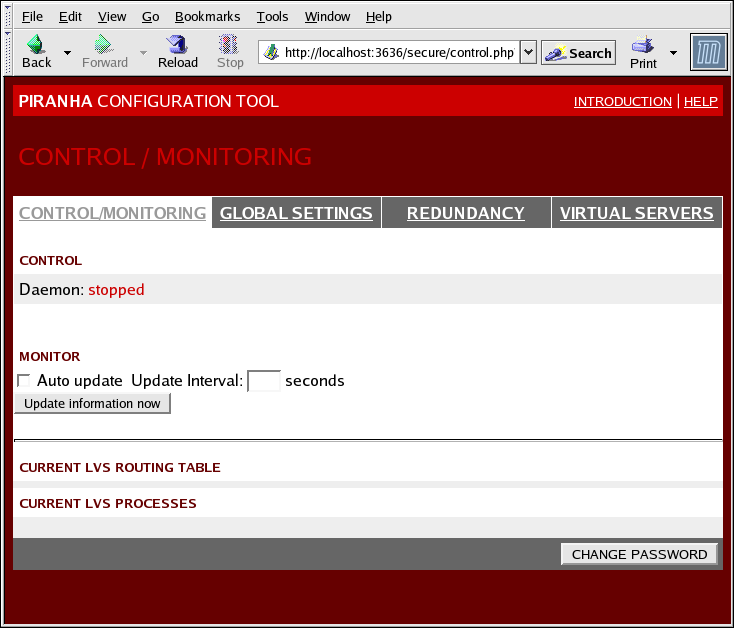
图 1.30. The CONTROL/MONITORING Panel
- Auto update
- 让状态显示按照「Update frequency in seconds」文本框里设置时间间隔(缺省为 10 秒)自动进行更新。我们不推荐将自动更新的时间间隔设置为少于 10 秒。这样使重新配置「Auto update」时间间隔变得困难,因为页面会过于频繁地更新。如果您遇到这个问题,只要简单地点击另外一个面板并回到「CONTROL/MONITORING」就可以了。
- Update information now
- 提供对状态信息的手工更新。
- CHANGE PASSWORD
- 点击这个按钮会使您进入一个帮助屏幕,上面有如何修改 Piranha Configuration Tool 的管理密码的信息。
1.10.2. GLOBAL SETTINGS

图 1.31. The GLOBAL SETTINGS Panel
- Primary server public IP
- 主 LVS 节点的公用真实 IP 地址。
- Primary server private IP
- 主 LVS 节点的替代网络接口的真实 IP 地址。这个地址仅用于与备份路由器之间的 heartbeat 通道。
- Use network type
- 选择 NAT 路由
- NAT Router IP
- 这个文本字段里是专用浮动 IP 地址。这个浮动 IP 地址应该作为真实服务器的网关。
- NAT Router netmask
- If the NAT router's floating IP needs a particular netmask, select it from drop-down list.
- NAT Router device
- 定义用于浮动 IP 地址的网络接口的设备名称,如
eth1:1。
1.10.3. REDUNDANCY
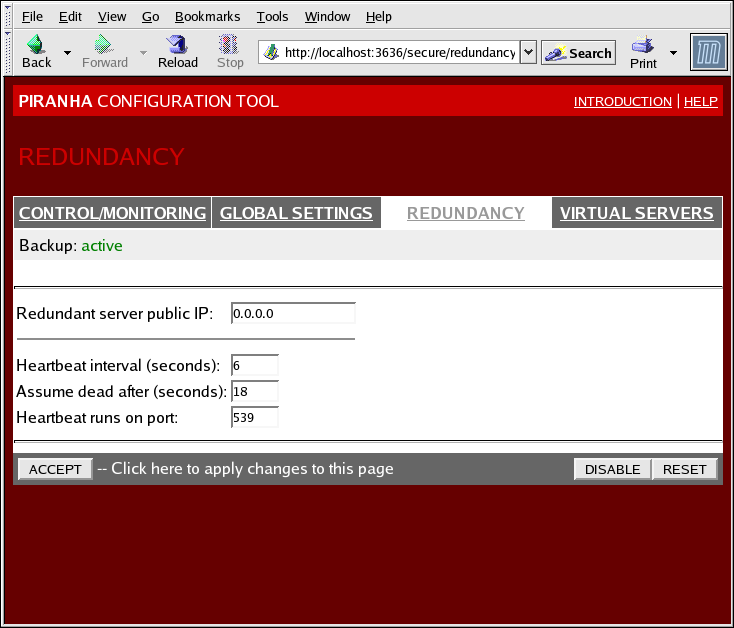
图 1.32. The REDUNDANCY Panel
- Redundant server public IP
- 备份 LVS 路由器的公用的真实 IP 地址。
- Redundant server private IP
- The backup router's private real IP address.
- Heartbeat Interval (seconds)
- 设置 heartbeat 之间间隔的秒数 — 备份节点检查主 LVS 节点功能性状态的时间间隔。
- Assume dead after (seconds)
- 如果主 LVS 节点在这段时间内没有响应,备份 LVS 路由器节点将初始化故障切换。
- Heartbeat runs on port
- 设置 heartbeat 与主 LVS 节点通信的端口。如果不填写这个字段,其省省值是 539。
1.10.4. VIRTUAL SERVERS
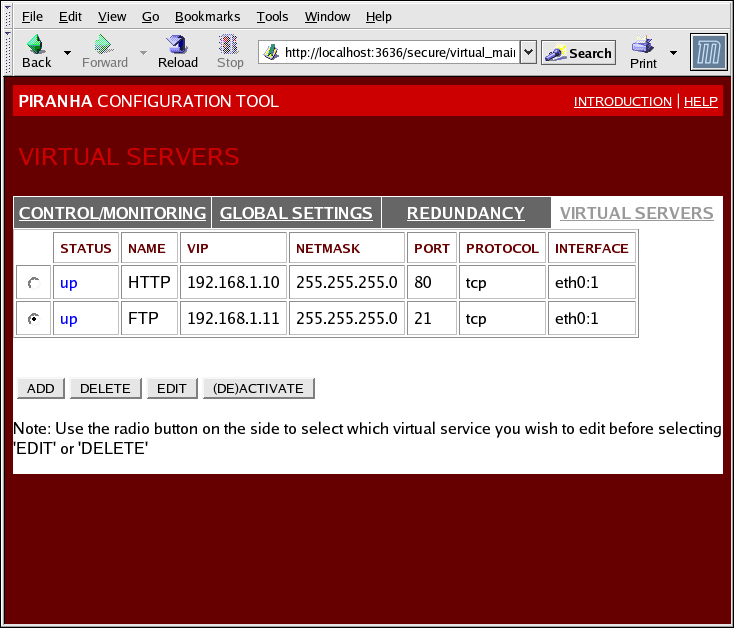
图 1.33. The VIRTUAL SERVERS Panel
1.10.4.1. 「VIRTUAL SERVER」分支
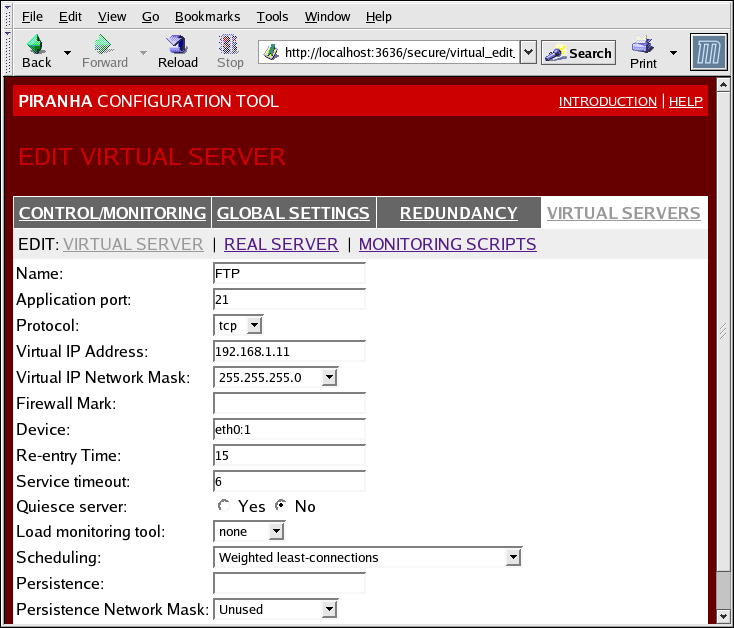
图 1.34. The VIRTUAL SERVERS Subsection
- Name
- 标识虚拟服务器的描述性名称。这个名称不是机器的主机名,所以可以使用描述性且易于辨别的文字。您甚至可以引用虚拟服务器使用的协议,如 HTTP。
- Application port
- 应用程序将侦听的端口。
- Protocol
- 在下拉菜单里提供 UDP 或 TCP 选项。
- Virtual IP Address
- The virtual server's floating IP address.
- Virtual IP Network Mask
- 可在下拉菜单里选择的虚拟服务器的掩码。
- Firewall Mark
- 捆绑多端口的协议或创建使用独立但相关的协议的多端口虚拟服务器时,输入的防火墙掩码整型数值。
- Device
- 「Virtual IP Address」里定义的浮动 IP 地址绑定的网络设备名称。您应该为连接至公用网络的以太接口的公用浮动 IP 地址起别名。
- Re-entry Time
- 服务器发生故障后,活动 LVS 路由器试图使用这个服务器前等待的时间(以秒为单位,整型数值)。
- Service Timeout
- 定义服务器被认为发生了故障或不可用之前的秒数的整型数值。
- Quiesce server
- 当「Quiesce server」单选按钮被选中时,新的服务器节点上线时,最少连接表被重置为 0,活动 LVS 路由器将发送请求,就好像所有的服务器都是刚加入群集一样。这个选项可以避免当大量的连接进入群集时,新加入的服务器超载。
- Load monitoring tool
- LVS 路由器可以用
rup或ruptime监控不同服务器上的负载。如果您从下拉菜单里选择了rup,那么每个服务器都必须运行rstatd服务。如果您选择了ruptime,每个服务器都必须运行rwhod服务。 - Scheduling
- 下拉菜单里的首选调度算法。缺省是
权重最少连接(Weighted least-connection)算法。 - Persistence
- 在处理客户事务时,如果您需要与虚拟服务器的持久的连接,可以使用这个属性。在这个文本字段里指定连接超时前允许的不活动时间(秒)。
- Persistence Network Mask
- 要将持久性限制到特定的子网,您可以从下拉菜单里选择合适的网络掩码。
1.10.4.2. 「REAL SERVER」分支
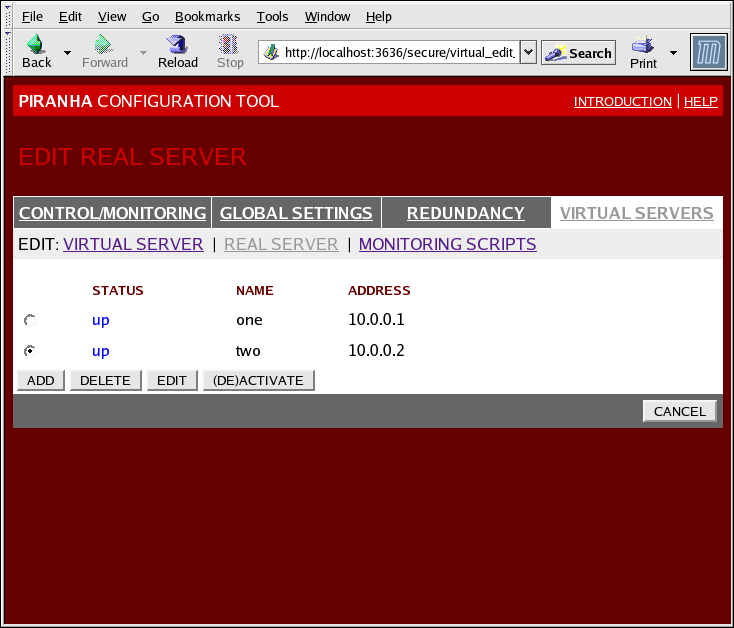
图 1.35. The REAL SERVER Subsection
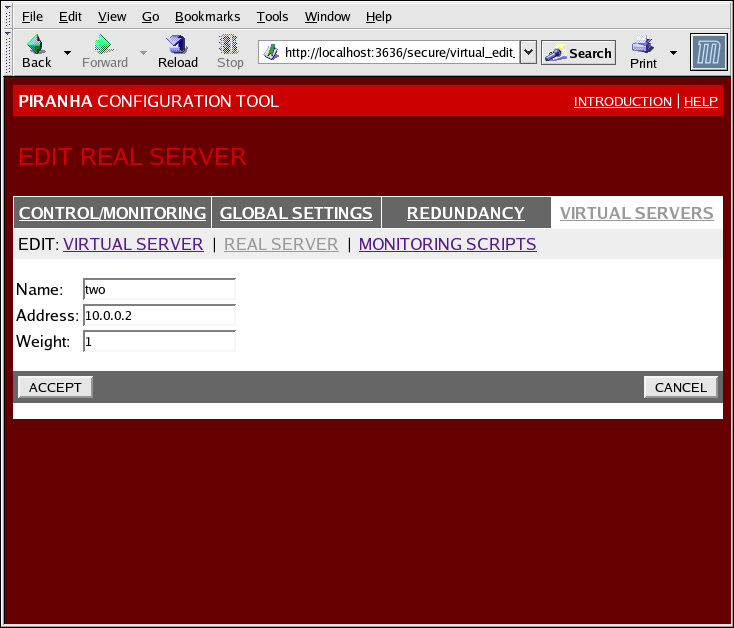
图 1.36. The REAL SERVER Configuration Panel
- Name
- 真实服务器的描述性名称。
注意
这个名称不是机器的主机名,它应该具有描述性且易于辨认。 - Address
- The real server's IP address. Since the listening port is already specified for the associated virtual server, do not add a port number.
- Weight
- An integer value indicating this host's capacity relative to that of other hosts in the pool. The value can be arbitrary, but treat it as a ratio in relation to other real servers.
1.10.4.3. EDIT MONITORING SCRIPTS Subsection
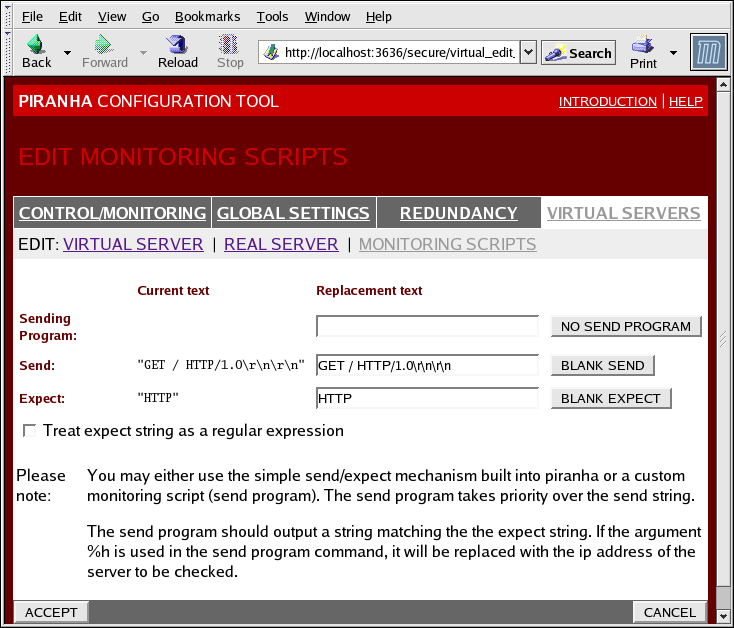
图 1.37. The EDIT MONITORING SCRIPTS Subsection
- Sending Program
- 对于更高级的服务验证,您可以使用这个字段来指定服务检查脚本的路径。这个功能对于需要动态更新数据的服务来说尤其有用,如 HTTPS 或 SSL。要使用这个功能,您必须编写一个返回文本型响应的脚本,将它设置可执行文件,并在「Sending Program」里输入其路径。
注意
如果在「Sending Program」字段里输入了外部程序,「Send」将被忽略。 - Send
nanny守护进程将这个字段里的字符串发送到每个真实服务器。这个字段里缺省是 HTTP 信息。您可以根据需要修改它。如果您让这个字段为空,nanny守护进程将试图打开服务端口,如果成功则假设服务正在运行。这个字段里只允许输入一个发送序列,且它只能包含可打印的、ASCII 字符串以及下面的转义符:- \n 新行。
- \r 回车。
- \t 制表符。
- \ 将下一个字符转义。
- Expect
- 如果服务器正常运行,它应该返回的文本型响应。如果您编写了自己的发送程序,在此输入您设定的服务器返回的响应。
第 2 章 Red Hat Cluster Suite 组件摘要
2.1. 群集组件
表 2.1. Red Hat Cluster Suite 软件子系统组件
| 功能 | 组件 | 描述 |
|---|---|---|
| Conga | luci | 远程管理系统 - 管理工作站。 |
ricci | 远程管理系统 - 被管理的工作站。 | |
| Cluster Configuration Tool | system-config-cluster | 以图形方式管理群集配置的命令 |
| 群集逻辑卷管理器(Cluster Logical Volume Manager,CLVM) | clvmd | 在群集中发布 LVM 元数据更新的守护进程。它必须在群集中的所有节点中运行,如果群集中的某个节点没有运行此时间进程则会提示错误。 |
lvm | LVM2 工具。为 LVM2 提供命令行工具。 | |
system-config-lvm | 为 LVM2 提供图形化用户界面。 | |
lvm.conf | LVM 配置文件。完整路径是 /etc/lvm/lvm.conf | |
| 群集配置系统(Cluster Configuration System,CCS) | ccs_tool | ccs_tool 是群集配置系统(CCS)的一部分。它被用来制作 CSS 配置文件的在线更新。此外,可用它将群集配置文件从使用 GFS 6.0(或更早版本)创建的 CCS 归档升级为 Red Hat Cluster Suite 发行版本中使用的 XML 格式。 |
ccs_test | 通过 ccsd 从配置文件获取信息的诊断和测试命令。 | |
ccsd | 在所有群集节点中运行并为群集软件提供配置文件数据的 CCS 守护进程。 | |
cluster.conf | 这个群集配置文件。完整的路径是 /etc/cluster/cluster.conf。 | |
| 群集管理器(Cluster Manager,CMAN) | cman.ko | CMAN 的内核模块。 |
cman_tool | 这是 CMAN 的管理前台。它启动和停止 CMAN 并能修改某些内部参数,如 vote。 | |
dlm_controld | 由 cman 初始脚本启动的守护进程,它管理内核中的 dlm;用户不可直接使用。 | |
gfs_controld | cman 初始脚本启动的守护进程,它管理内核中的 gfs;用户不可直接使用。 | |
group_tool | 用来获取与保护(fencing)、DLM、GFS 相关的组群列表,并获取调试信息,包括 cman_tool services 在 RHEL 4 中提供的信息。 | |
groupd | cman 初始脚本启动的守护进程,它是 openais/cman 和 dlm_controld/gfs_controld/fenced 之间的接口;用户不可直接使用。 | |
libcman.so.<version number> | 需要和 cman.ko 交互的程序所使用的库。 | |
| 资源组管理器(Resource Group Manager,rgmanager) | clusvcadm | 手动启用、禁用、迁移和重启群集中用户服务的命令。 |
clustat | 用来显示群集状态(包括节点成员资格和运行的服务)的命令。 | |
clurgmgrd | 用来处理用户服务请求,如服务启动、服务禁用、服务迁移和服务重启的守护进程。 | |
clurmtabd | 处理群集的 NFS 挂载表的守护进程。 | |
| 保护(Fence) | fence_apc | 用于 APC 电源开关的保护代理。 |
fence_bladecenter | 用于带有 Telnet 接口的 IBM Bladecenter 的保护代理。 | |
fence_bullpap | 用于 Bull Novascale 平台管理处理器(Platform Administration Processor,PAP)接口的保护代理。 | |
fence_drac | 用于 Dell 远程访问卡的保护代理。 | |
fence_ipmilan | 用于通过 LAN 使用智能平台管理界面(Intelligent Platform Management Interface,IPMI)进行控制的保护代理。 | |
fence_wti | 用于 WTI 电源开关的保护代理。 | |
fence_brocade | 用于 Brocade 光线通道开关的保护代理。 | |
fence_mcdata | 用于 McData 光线通道开关的保护代理。 | |
fence_vixel | 用于 Vixel 光线通道开关的保护代理。 | |
fence_sanbox2 | 用于 SANBox2 光线通道开关的保护代理。 | |
fence_ilo | 用于 HP ILO 接口的保护代理(以前是 fence_rib)。 | |
fence_rsa | 用于 IBM RSA II 的 I/O 保护代理。 | |
fence_gnbd | 用于 GNBD 存储的保护代理。 | |
fence_scsi | 用于 SCSI 持久保留的 I/O 保护代理。 | |
fence_egenera | 用于 Egenera BladeFrame 系统的保护代理。 | |
fence_manual | 手动交互的保护代理。注意:产品环境不支持这个组件。 | |
fence_ack_manual | fence_manual 代理的用户界面。 | |
fence_node | 在单个节点上执行 I/O 保护的程序。 | |
fence_xvm | 用于 Xen 虚拟机的 I/O 保护代理。 | |
fence_xvmd | 用于 Xen 虚拟机的 I/O 保护代理宿主。 | |
fence_tool | 加入和离开保护域的程序。 | |
fenced | I/O 保护守护进程。 | |
| DLM | libdlm.so.<version number> | 支持分布式锁管理器(Distributed Lock Manager,DLM)的库。 |
| GFS | gfs.ko | 在 GFS 文件系统使用的内核模块,并在 GFS 群集节点中载入。 |
gfs_fsck | 修复未挂载 GFS 文件系统的命令。 | |
gfs_grow | 扩展挂载的 GFS 文件系统的命令。 | |
gfs_jadd | 在已挂载的 GFS 文件系统里添加日志的命令。 | |
gfs_mkfs | 在存储设备中创建 GFS 文件系统的命令。 | |
gfs_quota | 在已挂载的 GFS 文件系统中管理配额的命令。 | |
gfs_tool | 配置或调整 GFS 文件系统的命令。这个命令也可以收集文件系统的各种信息。 | |
mount.gfs | mount(8) 所调用的挂载辅助工具;用户不可直接使用。 | |
| GNBD | gnbd.ko | 在客户端中使用 GNBD 设备驱动程序的内核模块。 |
gnbd_export | 在 GNBD 服务器中创建、导出和管理 GNBD 的命令。 | |
gnbd_import | 在 GNBD 客户中导入和管理 GNBD 的命令。 | |
gnbd_serv | 允许节点通过网络导出本地存储服务器守护进程。 | |
| LVS | pulse | This is the controlling process which starts all other daemons related to LVS routers. At boot time, the daemon is started by the /etc/rc.d/init.d/pulse script. It then reads the configuration file /etc/sysconfig/ha/lvs.cf. On the active LVS router, pulse starts the LVS daemon. On the backup router, pulse determines the health of the active router by executing a simple heartbeat at a user-configurable interval. If the active LVS router fails to respond after a user-configurable interval, it initiates failover. During failover, pulse on the backup LVS router instructs the pulse daemon on the active LVS router to shut down all LVS services, starts the send_arp program to reassign the floating IP addresses to the backup LVS router's MAC address, and starts the lvs daemon. |
lvsd | 一旦被 pulse 调用,lvs 守护进程就会在活跃的 LVS 路由器中运行。它读取配置文件 /etc/sysconfig/ha/lvs.cf,调用 ipvsadm 工具来构建和维护 IPVS 路由表,并为每个配置的 LVS 服务分配 nanny 过程。如果 nanny 报告某个服务器关闭了,lvs 将指引 ipvsadm 工具从 IPVS 路由表中删除这个服务器。 | |
ipvsadm | 这个服务更新内核中的 IPVS 路由表。lvs 守护进程通过调用 ipvsadm 添加、修改或删除 IPVS 路由表里的条目来设立并管理 LVS。 | |
nanny | nanny 监控守护进程在活跃的 LVS 路由器中运行。通过这个进程,活跃的 LVS 路由器可以决定每个服务器的健康状况,或者监控其工作负载。单独的进程将用于每个服务器上定义的每个服务。 | |
lvs.cf | 这是 LVS 的配置文件。其完整路径是 /etc/sysconfig/ha/lvs.cf。所有守护进程都直接或间接地从这个文件获取配置信息。 | |
| Piranha Configuration Tool | 这个用于监控、配置和管理 LVS 的基于 web 的工具。它是维护 /etc/sysconfig/ha/lvs.cf LVS 配置文件的默认工具。 | |
send_arp | 在故障切换过程中,当浮动 IP 地址从一个节点更改为另一个节点时,这个程序发送 ARP 广播。 | |
| Quorum 磁盘 | qdisk | 用于 CMAN / Linux-Cluster 的基于磁盘的 quorum 守护进程。 |
mkqdisk | 群集 Quorum 磁盘工具。 | |
qdiskd | 群集 Quorum 磁盘守护进程。 |
2.2. Man Page
- 群集基础结构
- ccs_tool (8) - 制作 CCS 配置文件的在线更新的工具
- ccs_test (8) - 诊断运行的群集配置系统的工具
- ccsd (8) - 访问 CCS 群集配置文件的守护进程
- ccs (7) - 群集配置系统
- cman_tool (8) - 群集管理工具
- cluster.conf [cluster] (5) - 群集产品的配置文件
- qdisk (5) - 用于 CMAN / Linux-Cluster 的基于磁盘的 quorum 守护进程
- mkqdisk (8) - 群集 Quorum 磁盘工具
- qdiskd (8) - 群集 Quorum 磁盘守护进程
- fence_ack_manual (8) - 作为手工 I/O 保护的一部分运行的程序
- fence_apc (8) - APC MasterSwitch 的 I/O 保护代理
- fence_bladecenter (8) - IBM Bladecenter 的 I/O 保护代理
- fence_brocade (8) - IBrocade FC switch 的 I/O 保护代理
- fence_bullpap (8) - PAP 管理控制台控制的 Bull FAME 架构的 I/O 保护代理
- fence_drac (8) - Dell 远程访问卡的保护代理
- fence_egenera (8) - Egenera BladeFrame 的 I/O 保护代理
- fence_gnbd (8) - 基于 GNBD 的 GFS 群集的 I/O 保护代理
- fence_ilo (8) - HP Integrated Lights Out card 的 I/O 保护代理
- fence_ipmilan (8) - IPMI 通过局域网控制的机器的 I/O 保护代理
- fence_manual (8) - 作为手工 I/O 保护的一部分运行的程序
- fence_mcdata (8) - 用于 McData FC switch 的 I/O 保护代理
- fence_node (8) - 在单个节点上执行 I/O 保护的程序
- fence_rib (8) - 用于 Compaq Remote Insight Lights Out card 的 I/O 保护代理
- fence_rsa (8) - IBM RSA II 的 I/O 保护代理
- fence_sanbox2 (8) - 用于 QLogic SANBox2 FC switch 的 I/O 保护代理
- fence_scsi (8) - 用于 SCSI persistent reservation 的 I/O 保护代理
- fence_tool (8) - 加入和离开保护域的程序
- fence_vixel (8) - 用于 Vixel FC switch 的 I/O 保护代理
- fence_wti (8) - 用于 WTI Network Power Switch 的 I/O 保护代理
- fence_xvm (8) - 用于 Xen 虚拟机的 I/O 保护代理
- fence_xvmd (8) - 用于 Xen 虚拟机的 I/O 保护代理守护进程
- fenced (8) - I/O 保护守护进程
- 高可用性服务管理
- clusvcadm (8) - 群集用户服务管理工具
- clustat (8) - 检查群集状态的工具
- Clurgmgrd [clurgmgrd] (8) - 资源组(群集服务)管理者守护进程
- clurmtabd (8) - 群集 NFS 远程挂载表守护进程
- GFS
- gfs_fsck (8) - 脱机 GFS 文件系统检查程序
- gfs_grow (8) - 扩展 GFS 文件系统
- gfs_jadd (8) - 在 GFS 文件系统里添加日志(jounal)
- gfs_mount (8) - GFS 挂载选项
- gfs_quota (8) - 控制 GFS 磁盘配额(quota)
- gfs_tool (8) - GFS ioctl 调用接口
- 群集逻辑卷管理者(Cluster Logical Volume Manager)
- clvmd (8) - 群集 LVM 守护进程
- lvm (8) - LVM2 工具
- lvm.conf [lvm] (5) - LVM2 的配置文件
- lvmchange (8) - 修改逻辑卷管理者的属性
- pvcreate (8) - 初始化 LVM 使用的磁盘或分区
- lvs (8) - 报告逻辑卷的信息
- 全球网络块设备(Global Network Block Device)
- gnbd_export (8) - 导出 GNBD 的接口
- gnbd_import (8) - 操纵客户机上的 GNBD 块设备
- gnbd_serv (8) - gnbd 服务器守护进程
- LVS
- pulse (8) - 监控群集节点健康状况的 heartbeating 守护进程
- lvs.cf [lvs] (5) - lvs 的配置文件
- lvscan (8) - 扫描(所有磁盘)的逻辑卷。
- lvsd (8) - 控制红帽群集服务的守护进程
- ipvsadm (8) - Linux 虚拟服务器管理
- ipvsadm-restore (8) - 从标准输入恢复 IPVS 表
- ipvsadm-save (8) - 把 IPVS 保存至标准输出
- nanny (8) - 监控群集里服务的状态的工具
- send_arp (8) - 将新的 IP 地址/MAC 地址映射通知网络的工具
2.3. 兼容的硬件
附录 A. 修订记录
| 修订历史 | |||
|---|---|---|---|
| 修订 3-8.400 | 2013-10-31 | Rüdiger Landmann | |
| |||
| 修订 3-8 | 2012-07-18 | Anthony Towns | |
| |||
| 修订 1.0-0 | Tue Jan 20 2008 | Paul Kennedy | |
| |||
索引
C
- cluster
- displaying status,Cluster Status Tool
- cluster administration
- displaying cluster and service status,Cluster Status Tool
- cluster component compatible hardware,兼容的硬件
- cluster component man pages,Man Page
- cluster components table,群集组件
- Cluster Configuration Tool
- accessing,Cluster Configuration Tool
- cluster service
- displaying status,Cluster Status Tool
- command line tools table,命令行管理工具
- compatible hardware
- cluster components,兼容的硬件
- Conga
- overview,Conga
- Conga overview,Conga
F
- feedback,反馈
I
- introduction,简介
- other Red Hat Enterprise Linux documents,简介
L
- LVS
- direct routing
- requirements, hardware,直接路由
- requirements, network,直接路由
- requirements, software,直接路由
- routing methods
- three tiered
- high-availability cluster,Three-Tier LVS Topology
M
- man pages
- cluster components,Man Page
N
- NAT
- routing methods, LVS,路由方法
- network address translation (见 NAT)
O
- overview
- economy,Red Hat GFS
- performance,Red Hat GFS
- scalability,Red Hat GFS
P
- Piranha Configuration Tool
- CONTROL/MONITORING,CONTROL/MONITORING
- EDIT MONITORING SCRIPTS Subsection,EDIT MONITORING SCRIPTS Subsection
- GLOBAL SETTINGS,GLOBAL SETTINGS
- login panel,Linux 虚拟服务器管理图形用户界面
- necessary software,Linux 虚拟服务器管理图形用户界面
- REAL SERVER subsection,「REAL SERVER」分支
- REDUNDANCY,REDUNDANCY
- VIRTUAL SERVER subsection,VIRTUAL SERVERS
- Firewall Mark ,「VIRTUAL SERVER」分支
- Persistence ,「VIRTUAL SERVER」分支
- Scheduling ,「VIRTUAL SERVER」分支
- Virtual IP Address ,「VIRTUAL SERVER」分支
- VIRTUAL SERVERS,VIRTUAL SERVERS
R
- Red Hat Cluster Suite
- components,群集组件
T
- table
- cluster components,群集组件
- command line tools,命令行管理工具

